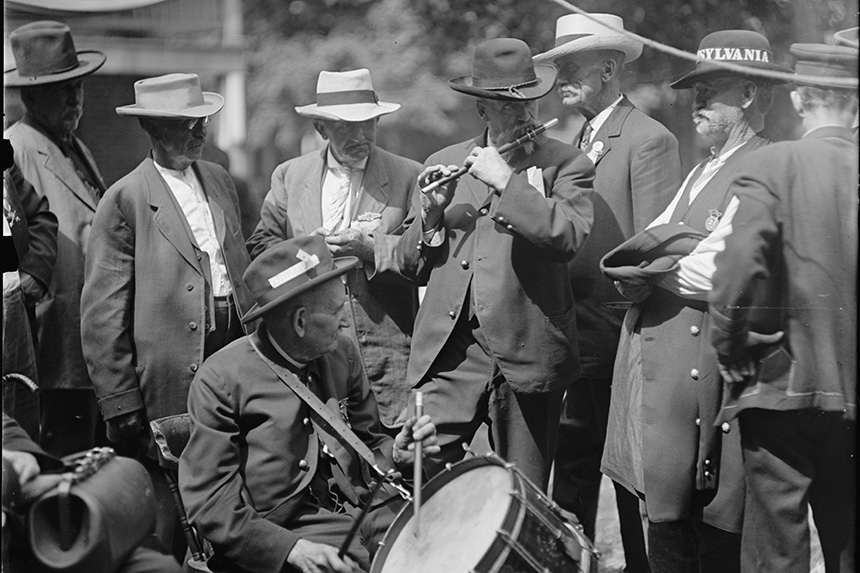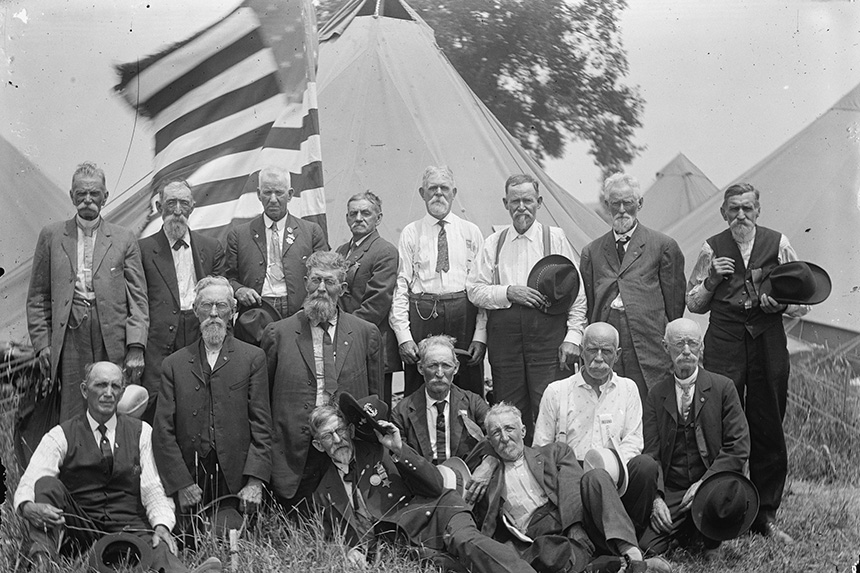Civil War Soldiers’ Final Reunion at Gettysburg
The old veterans couldn’t wait to come. Roads ran thick with automobiles and horse buggies. Most arrived on the nation’s sprawling rails. A few walked more than 100 miles. An 85-year-old man, fearing his son would prevent him from going, crawled out a window and caught a train.
Altogether, an estimated 50,000 of the blue and gray trekked to the Great Reunion, a grand commemoration at iconic Gettysburg, on that battle’s 50th anniversary: July 1 to 3, 1913.
Why did they go? According to the many politicians and generals who also came to the reunion, the reason was clear: There was an urgent need for unity. At that very moment, U.S. ground forces were in Cuba, Mexico, Nicaragua, and the Philippines. Trouble in the Balkans threatened to escalate into a much larger European crisis. Not mentioned but certainly pressing were the many bitter divisions at home. Conservatives were continuously fighting progressives over Jim Crow and lynching, female suffrage, overseas expansion, immigration, and labor rights. In this time of peril, so said the organizers, only the finest of military heroes could save our great nation.
But as the famous and powerful gave their speeches, exalting the virtues of suffering and death, the vast majority of the old soldiers spent their time at Gettysburg seeking something else: proof of life and a chance to heal.
“I will see if I can find the exact spot where I was struck with a federal ‘minnie’ ball.”
—Confederate F.O. Yates
For half a century, survivors of the nation’s deadliest war struggled with memories of combat, the loss of comrades to bullets and disease, recurring nightmares, and lingering visions of killing fellow humans. Just as crippling was the loneliness. As supportive as family and friends could be, veterans needed other veterans to talk to, and their numbers were dwindling. An aging James Vernon, formerly a young lad in the 18th Virginia Infantry Regiment, said of warfare, “Those who were not there can form no idea of it.”
Tradition credits a fellow veteran for proposing a final, encompassing Civil War reunion, one Henry S. Huidekoper of the 150th Pennsylvania Infantry Regiment, who had lost an arm at Gettysburg. In short order, Gettysburg businessmen and city officials adopted the idea, and within months the Pennsylvania governor and state legislature supported the project. A year before the anniversary, a commission of former high-ranking officers of the blue and gray solicited help from the federal government, and interest rapidly grew.
Six months out, it was evident that this was going to be a phenomenon. The Williamsburg, Virginia, Gazette predicted the reunion would be “the greatest gathering of conqueror and conquered in the history of the world.” Slated to speak were outgoing President William Howard Taft, Chief Justice Edward White, Speaker of the House Champ Clark, the newly elected President Woodrow Wilson, and a score of governors — plus bankers, business moguls, and time allowing, a few high-ranking Civil War officers. Every major newspaper was sending correspondents. The total budget for the affair, most of it coming from the Pennsylvania and New York state assemblies and the U.S. War Department, was $1.2 million (or about $31 million in 2019 dollars).
Yet only a few hand-picked veterans were invited to speak, and none were African American. Nor were nurses or other civilians given a chance to tell their story. The organizers expected perhaps 5,000 veterans would arrive by June 29, two days before the reunion’s official start. But the people came like a collective flood. When the number exceeded 18,000 that day alone, the hosting U.S. War Department scrambled to accommodate the overflow. By July 1, the start of the anniversary celebration, veterans and tourists had transformed Gettysburg into the third largest city in Pennsylvania.
Once on site, veterans were not making declarations of peace and unity. Instead, their first inclination was to find specific locations that held personal meaning. Frail and failing Hugh Meller of Fairport, New York, was determined to see the room at the Western Maryland Railroad Station where he had been held captive for two days. With the help of two men, he ascended a stairway to the second floor. “All these later years I have feared that the old station had been demolished,” Meller told a reporter. “How glad I was when I saw the familiar building upon my arrival.” Confederate F.O. Yates wanted to see precisely where he clashed with Union infantry on July 3. “I charged within 50 feet of the federal lines on top of Gettysburg Heights. I will see if I can find the exact spot where I was struck with a federal ‘minnie’ ball,” he said. Samuel Marks, who served with the 53rd North Carolina Infantry, found the hill where he had to leave his dying brother behind.
While exploring Seminary Ridge, where the warring parties tangled on the battle’s first day and from which Confederates launched their doomed “Pickett’s Charge” in the contest’s final hours, two strangers immediately recognized a shared trait: each was missing a right arm. An ensuing conversation revealed that both received their wounds within minutes of each other, only a few hundred yards apart on that same ridge.

While the politicians proclaimed that the old soldiers had moved on from the Civil War, in reality, sectional animosities lingered. Many Confederates arrived in gray uniforms, lofting Confederate battle flags. Unionists, predominantly in civilian attire, reminded them who had won. The general white Southerner consensus was that the war was an invasion, while Northerners considered the Confederacy treasonous. Yet they reached for each other, hoping to make sense of their shared traumatic past.
Seven Gettysburg survivors traveled together all the way from Phoenix, Arizona, even though they fought for different states — Georgia, Indiana, Minnesota, New York, Pennsylvania, and Virginia. Upon their arrival, the group retraced their steps, trying to piece together where each exactly stood and what had happened to them. After moments of initial confusion, the landmarks slowly became familiar, and the memories horrifically vivid. Yet in retelling their own struggle, they found understanding, empathy, even solace.
All the veterans came in hopes of finding fellow members of their old regiments. Unwittingly, reunion organizers made this very difficult: The vast “Great Encampment” was organized by state, but veterans were assigned to the area where they currently lived, not with the state they had served during the war. They were left to search a two-mile area, often with little or no knowledge of their comrades’ locations. Joshua Vinson looked in vain for fellow members of his Virginia cavalry unit. By sheer chance, Remi Boerner happened upon an old friend from the 91st Pennsylvania. The two warmly embraced, having not seen each other since 1865. Former Hoosier Frank Fickas searched among the 74 tents housing men from his old home state. “Is there anybody here from the 14th Indiana?” he beckoned. Finally, he saw a familiar face, and the man responded, “I’m here, Frank, the only one.”
At least one veteran lugged away a suitcase full of soil from the site where he had fought.
Such was the pattern throughout the week. When queried by his hometown paper, a North Carolinian said, “How did we put in our time? We scattered.” A journalist from the local Adams County News marveled at how this “national reunion” was instead predominantly intimate and personal. “The old soldiers by twos and threes found each other, and in camp or on the field they spent hours talking.”
The Commemoration officially began at 3 p.m. on July 1 in the Great Tent, an immense, sweltering canopy that seated 13,000. Lindley Garrison, the U.S. Secretary of War, was the day’s keynote. Like President Woodrow Wilson, who had appointed him, Garrison had no military experience himself. Still he felt qualified to pontificate grandly. “Fifty years ago today, there began here one of those conflicts between man and man, marked by such exhibitions of valor, courage, and almost superhuman endurance as to engrave itself upon the tablet of history,” he intoned. “Equal met equal, and in the domain of physical prowess all were worthy of medals of honor.” Garrison also contended that the veterans had put the past far behind them, claiming “the last embers of the former time have been stamped out.”
In speech after speech, bankers, congressmen, and governors proclaimed there existed a collective, patriotic, unifying amnesia. Notably, relatively few veterans listened to any of it. Heads of state implored veterans to forget, when they could not. “The arrival of the Secretary of War,” a reporter from the Philadelphia Inquirer observed, “stirred but passing interest in the hearts of the men … the vast majority [of veterans] spent the day out on the familiar old battlefield, in the tents of their comrades, or looking for the spots they occupied 50 years ago.”

Throughout July 2 and 3, the orations continued, placing veterans on pedestals — and consequently out of reach. On July 4, despite having initially rejected an invitation to attend, President Wilson arrived and delivered yet another ingratiating tribute to warriors and warfare. In a brief and stilted address, Wilson insisted “We are made by these tragic, epic things to know what it costs to make a nation — the blood and sacrifice of multitudes of unknown men …” Once again, few veterans were in attendance. Those who were present generally expressed disappointment. “President Wilson failed to stir the heart of the veterans,” observed one reporter. “Not once was he interrupted by a handclap or a cheer.” Wilson departed after spending a mere 45 minutes on site. At least Wilson made an appearance. Former President Taft and Chief Justice White reneged on their invitations.
After this final oration, the veterans began to pack their bags, leave their tents, and start for home. They carried away an assortment of souvenirs. Conspicuously absent were instruments of death — bullets, bayonets, or swords. The old soldiers’ most cherished keepsakes were things that were living, or had once been alive. One man saved a pine sapling. Another held a branch from a tree that had shielded him in the battle. J.C. McMasters took wheat from the fields back to his Indiana home. A surgeon from New Orleans pocketed some oak leaves from the Copse of Trees, the iconic epicenter of fighting on the battle’s final day. Many leaned on walking sticks harvested from the groves, a support to them in multiple ways. At least one veteran lugged away a suitcase full of soil from the site where he had fought. “I shall make a garden box of it,” he reportedly said.
Men like Wilson and Garrison ambled back to Washington, declaring the reunion a lesson in selfless sacrifice for the nation’s youth, but hardly mentioning the event ever again. In contrast, the veterans remembered this last, great gathering for the rest of their lives, because it gave them a chance to tell their own stories, make their own music, and remember their own history — virtually none of which would appear in the official narratives.
Thomas Flagel is an associate professor of history at Columbia State Community College in Franklin, Tennessee, and the author of War, Memory, and the 1913 Gettysburg Reunion.
This article originally appeared at Zocalo Public Square. It is featured in the July/August 2020 issue of The Saturday Evening Post. Subscribe to the magazine for more art, inspiring stories, fiction, humor, and features from our archives.
Featured image: Shared history: An estimated 50,000 veterans gathered in Gettysburg in 1913 to commemorate their roles in the bloodiest battle ever fought on American soil. As one soldier said at the time, “Those who were not there can form no idea of it.” (Library of Congress)